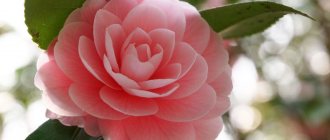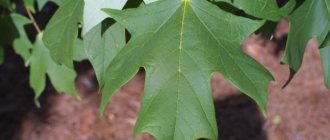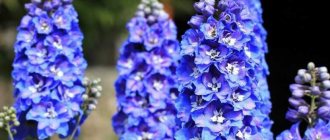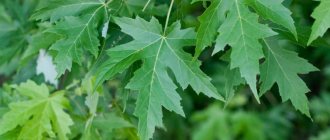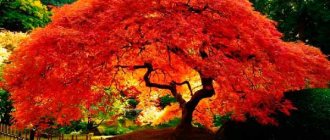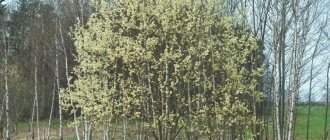Russian botanists regularly added to the lists of famous plants on the planet. Back in the 19th century, employees of the Imperial Academy of Sciences counted and described plants living on the territory of the empire, as well as those growing outside its borders.
Some plants were not included in the list . The Atser Ginnala maple was described outside of a single list, after the completion of the inventory, when in the middle of the same nineteenth century, a specimen of the Ginnala maple was brought to the St. Petersburg Botanical Garden from the Far East.
This shrub plant was to the taste of the imperial court and the tree began to be included in arboretums and gardening farms, organically fitting into design structures.
Features of cultivation
Planting a ginnala maple and caring for the tree will not be particularly difficult. It is important to follow some rules.
Maple loves sunlight, so the planting site should be sufficiently lit. Light partial shade is acceptable. But in the shade, the tree will lose its autumn decorative effect: the color of the leaves will not be bright.
Although ginnala loves damp places, it absolutely cannot tolerate stagnation of water at the roots. Good drainage will help avoid this problem.
Maple should not be planted in a place where beets, potatoes and sunflowers grew before it in order to avoid infection with diseases that they have in common.
Ginnala prefers light and loose soils. It will grow poorly on clay soils.
Description of the plant
Ginnala Maple, or Riverside Maple, is a domesticated shrubby plant from the Sapindaceae family, which reaches three to ten meters in height. Habitats: the north of Asia and the Siberian part of the Eurasian continent.
In nature, Ginnala prefers to grow on the shores of reservoirs , along river banks, which is why it received its second name (riverside). Atser Ginnala was sometimes confused with Tatarian maple .
This shrub is distinguished by an unusually shaped crown - in an adult plant it is in the form of a tent.
In May-June, the maple blooms with yellow buds collected in inflorescences. The buds of Ginnala flowers are small in size and are formed into panicle-shaped bunches of fifteen to twenty units in one.
As soon as the bush fades, the formation of fruits begins in place of the inflorescences - lionfish blades, which upon maturity reach three centimeters in size. The ripe fruit is distinguished by a bright red color.
At the final stage of vegetative development, the leaves become burgundy if the shrub grows in direct sunlight, or yellow if the maple grows in a shady place.
Features of maple
Botanists unanimously tend to call the Ginnala maple an unpretentious and undemanding representative of the ornamental shrub plants. The main advantage of this species is its high frost resistance.
This makes the river maple stand out against the background of plants such as sakura, mountain ash or rose hips. River maple is able to withstand frosts down to minus forty degrees Celsius, without any consequences. In addition, the shrub easily tolerates direct sunlight. Resistant to dry and hot climates.
Ginnala maple feels comfortable on soil poor in minerals and vitamins . But, at the same time, riverine maple does not easily tolerate shady areas, and also does not like groundwater of excessively high concentrations. However, riverine maple loves moisture.
Ginnala grows slowly, adding up to thirty centimeters per year. But, despite such a leisurely development, maple of this species is capable of living up to one hundred and even two hundred and thirty years.
Gardeners and landscape designers willingly use Atser Ginnala to decorate the area . The tree is loved for its decorative properties. Ginnala maple remains attractive throughout the growing season.
Care
Maple care comes down to simple but regular procedures that even a novice gardener can easily master.
Watering
During the first month after planting, the tree needs to be watered every week. Next, switch to one-time watering per month.
In dry weather, additional weekly watering is required.
Feeding
For the first 2 years, the seedling does not need to be fed. However, if there are not enough nutrients in the soil, then in the spring you need to add urea (at the rate of 40 g per square meter), superphosphate (up to 50 g per square meter), potassium salts (up to 25 g per square meter).
Summer fertilizing is conveniently done with special complex fertilizers.
Trimming
Maple pruning is divided into sanitary and formative.
Sanitation is done in the spring and protects the plant from possible breeding grounds for diseases. In this case, all cut material must be burned in order to destroy the larvae of pests, parasites and microbes.
Formative pruning gives the tree the desired decorative shape. It is carried out in late autumn or early spring at a time when the movement of juices has not yet begun.
External links [edit]
- Data related to Acer ginnala at Wikispecies
- Winter ID pictures
| Taxon identifiers |
|
Pests and diseases
There are a number of fungal diseases that affect leaves.
Powdery mildew
The disease is manifested by the appearance of a white coating on the leaf plate. By the end of the season, first yellow and then black spots become noticeable on the leaves. Frosts do not protect against the disease: it goes into the ground, and with the onset of warmth it affects young leaves.
White spot
External signs of the disease (white spots) become noticeable only at the end of summer. Although the plant became infected at the beginning of the season.
Brown spot
Brown or red spots of infection appear on the surface of the leaves.
Taphrina polyspora
A fungal disease causes leaf deformation.
Maple branches and the trunk itself can also be affected.
Wilt
The disease disrupts the plant's metabolism, which often leads to the death of the maple.
Nectria necrosis
Spread by rainwater and insects.
Cytosporosis
When the disease occurs, necrotic spots appear on the affected bark.
Diplodia necrosis
Signs of the disease are black, rough growths.
To obtain a healthy maple specimen, you need to regularly inspect the tree, and at the first signs of disease, promptly begin treatment.
Cut and removed parts should be burned immediately to prevent the spread of disease.
Tatarian maple. Morphology
A small tree or shrub with several stems 2-12 m high. The bark is thin, pale gray-brown, smooth with dark grooves, and becomes covered with cracks with age. The branches are thin, angular, smooth or slightly pubescent, red-brown, with prominent leaf scars and short, wide, dark red-brown buds.
The leaves are simple, opposite, with serrate or biserrate edges, usually entire or with 2-5 lobes, broadly oval or deltoid, 5-11 cm long, half as wide in width, green above, paler below, pubescent along the veins. In autumn the leaves turn bright red and then fall off. Leaf petioles are 2-5 cm long, thin, often with a slight shade of pink.
The flowers are white-green with a slight shade of red, 5-8 mm in diameter, fragrant, on long stalks, collected in a thick corymbose panicle, appearing immediately after the leaves in spring.
The fruit is a lionfish, consisting of two identical halves, each 2.0-2.5 cm long, diverging at an acute angle. The wings of the seed are green or red and turn brown in the fall. The seed ripens in late summer or early autumn and remains on the tree.
Tatarian maple grows slowly, is frost-resistant and shade-tolerant, and tolerates dry and salinized soil. It is a good honey plant.
In its morphological properties it is close to river maple (Acer ginnala), which some botanists consider a subspecies of Tatarian maple A. tataricum subsp. ginnala. They are distinguished in particular by the leaves, which are shiny in the river maple (matte in the Tatarian maple), and the individual blades are clearly defined and much more deeply cut.
Application
The ginnala maple is loved by gardeners and is used quite actively in landscape design. In summer it attracts attention with its original shape of foliage and crown. And in the fall the garden colors with red, orange or yellow colors.
Ginnalu can be planted separately from other plants. This will be a wonderful single specimen with a beautifully formed crown.
Maple can be used to create a hedge.
Ginnala goes well with lilac or barberry. And the autumn contrast of bright foliage and green needles creates a truly impressive picture.
Ginnala is also an excellent honey plant. It blooms precisely during the period when bees experience interruptions in flowering plants. Therefore, ginnala becomes a real lifesaver for them.
Maple bark contains tannins. And its leaves have been used in China since ancient times to produce black paint.
Ginnala maple is an excellent choice for landscaping and decorating a garden or summer cottage. Beautiful and unusual, its appearance will delight the owners and attract the attention of guests. Plant a ginnala maple in your garden and add a variety of shapes and colors to the composition of the area.
Reproduction
Reproduction occurs:
- Plot near a pond: nuances of choice
- Which fast-growing shrubs are suitable for green fences?
- Juniper stricta - description, cultivation, planting and care. Secrets of garden maintenance and application in landscape design (130 photos and videos)
- by seed method;
- cuttings;
- vaccination.
Propagation by seeds
This method is used in spring or autumn. In the first case, the seeds must be stratified by first placing them in a pot of river sand and then leaving them in the refrigerator for 90 days. They are usually planted in open ground in mid-April or May.
If you want to improve root germination, then first soak the seed in hydrogen peroxide for three days. You can see the first shoots after half a month.
Autumn planting does not require stratification. It is produced in late autumn, just before the snow.
Caring for seedlings includes weeding, loosening and watering. You will also need a shading device. Plants are transplanted to their permanent place of residence after a year or three.
Propagation by cuttings
The method involves planting pre-prepared cuttings up to 25 cm long. For the winter, they are buried in the ground, and only in the spring they are planted in separate containers.
- How to grow a plum from a seed: tips and tricks on how to prepare the soil, prepare fertilizers and grow plums at home (155 photos + video)
- Do-it-yourself columnar foundation for a gazebo: instructions, diagrams, calculations
- How to choose the right fruit trees and shrubs for planting
Reproduction by vaccinations
This is the most common technology for propagating decorative maple. Vaccinations are divided into:
- budding;
- copulation.
The length of the trunk can vary from 0.5 to 3 m. The optimal time for the procedure is the beginning of spring.
Ginnala maple is used quite often in landscape design of garden plots. This is due to its aesthetic appearance. Therefore, if you are thinking about decorating your local area, then be sure to take a closer look at this ornamental shrub.
Treatment options
The main condition for successful recovery is to notice the source of infection in time. Therefore, it is recommended, especially in summer, to carefully inspect the trunks, branches and leaves of trees every week. Even if at first glance the Ginnala maple is completely healthy, protective preventive measures are still necessary.
Places where beets, potatoes, and sunflowers previously sprouted are not suitable for this tree, as they could potentially be a source of infectious wilt disease.
An effective method of prevention is timely pruning, which can be used to remove damaged areas. These branches, leaves and trees should not be left on the site, as the fungal infection can spread to healthy plants.
Usage
This maple species can be used as a hedge. This method is common in cities. Frequently planted trees can be found around the roads. In late autumn or early spring, the crown is trimmed, giving it a neat shape. These trees are also used to decorate suburban areas, creating beautiful compositions. In parks and squares you can find both groups and a single standing Ginnala maple.
Features of this breed:
- sufficient frost resistance of an adult tree;
- germination on any type of soil;
- resistance to arid climates;
- love for a lot of light.
Advice from experienced gardeners
- When purchasing seedlings, special attention is paid to the root system. Be sure to check for growths and other diseases. If the roots are well developed, but the tree itself is very flimsy, then this indicates some kind of violation.
- Planting is carried out only in spring or summer.
- To prevent trees from killing each other, it is recommended to maintain a distance of 2-4 meters between seedlings.
- When a maple disease occurs, the affected branches are completely cut off, and the cut points are treated with a special garden varnish.
Planting in open ground
To achieve the greatest decorative effect of the Ginnala maple (Acer ginnala), you should choose sunny areas for planting it, where its foliage will acquire contrasting colors of yellow and scarlet with the arrival of autumn.
The plant will develop normally even with slight shading, but the decorative effect will be lower.
Although maple is undemanding when it comes to soil composition, it still has certain preferences. It is worth growing a tree or shrub on loose, light soils with a slightly acidic reaction. If the pH value is 4.5 - 5.5, then the soil should be acidified using high-moor peat or special fertilizers.
Planting of the Ginnala maple is carried out in spring or autumn, which depends on the agroclimatic conditions of the cultivation region. In northern regions, it is preferable to plant the plant in the spring so that it has enough time to take root.
Planting work is carried out in the following order:
- 2 weeks before the main work, a planting hole is dug with a depth and diameter of 50 cm or a hedge trench with similar parameters, where organic fertilizers (compost, humus) are placed.
- After the specified time, if the groundwater is close, the bottom of the depression is lined with drainage material - crushed stone or broken brick.
- Next, a little soil mixture of the extracted soil, peat and sand is poured in, on which the seedling is installed.
- When forming a “green” fence, a distance of 1–2 m is maintained between seedlings.
- The hole (trench) is filled with the prepared substrate so that the root collar is flush with the ground.
- The area around the trunk is trampled, watered and mulched.
How to care for river maple
The variety is not demanding in terms of care. If you meet the basic agrotechnical requirements for cultivation, the colorful Ginnala maple will become the highlight of the landscape composition.
- Watering. You won't have to water the maple tree often. It is enough to pour 2 buckets of water into the tree trunk every month. The consumption rate increases only during prolonged drought.
- Feeding and fertilizer. In the first year after planting, the Ginnala maple is fed only if the fertile soil layer was not enriched before planting. For spring and summer fertilizing, complex mineral fertilizers are used. For autumn digging, you can add organic matter - compost or humus.
- Soil treatment. Loosening after precipitation or watering is not carried out deeply due to the superficial root system of the plant, in order to avoid injury to it. If weeds appear, they should be removed immediately. When mulching, the frequency of soil treatment procedures is significantly reduced.
- Trimming. It is necessary to form a crown in the spring before the buds swell. At the same time, diseased, dried branches are pruned. If maple is used to form a hedge, then pruning is carried out as the shoots grow.
- Shelter for the winter. Young specimens need to be protected from frost. Mulch and spruce branches are used for protective purposes.
